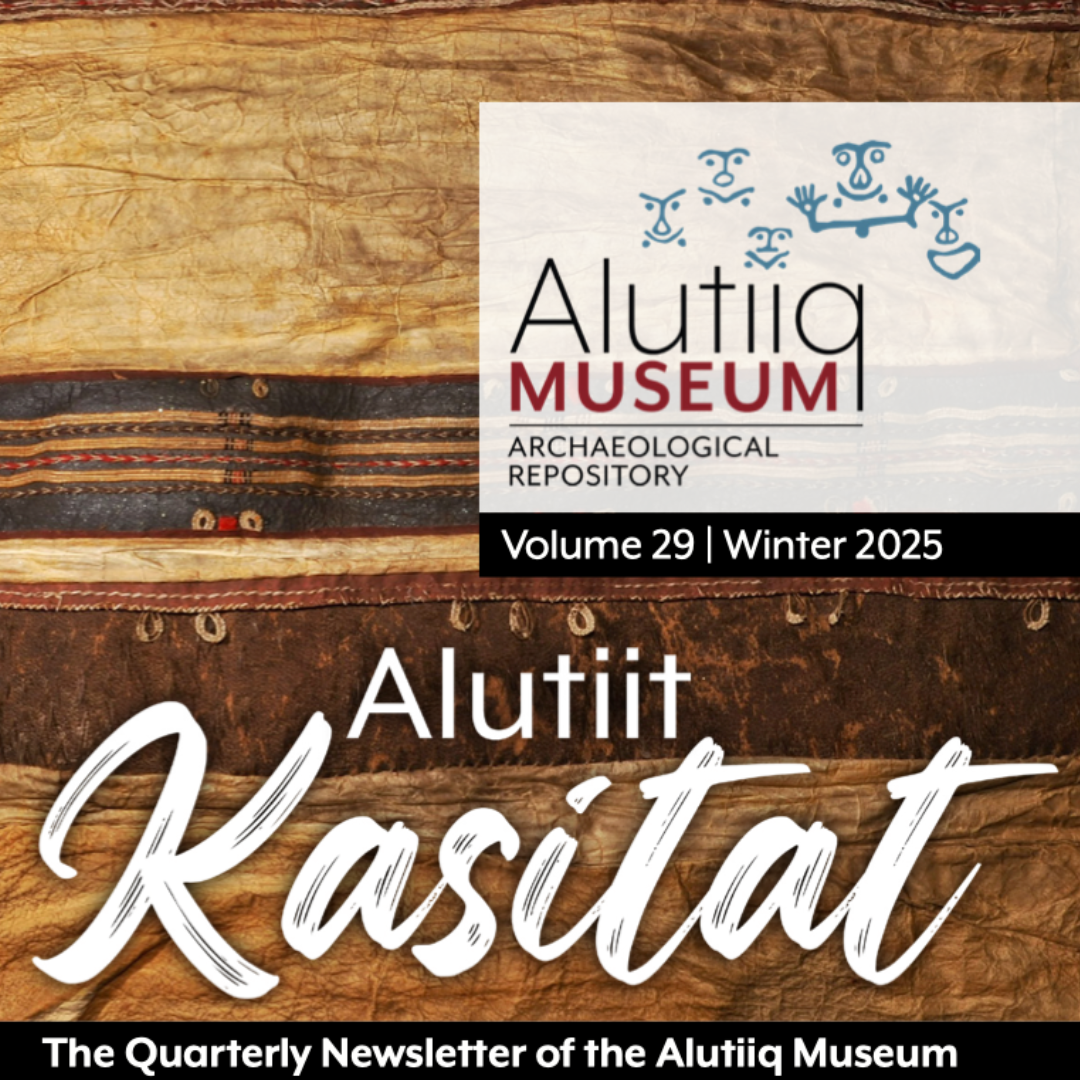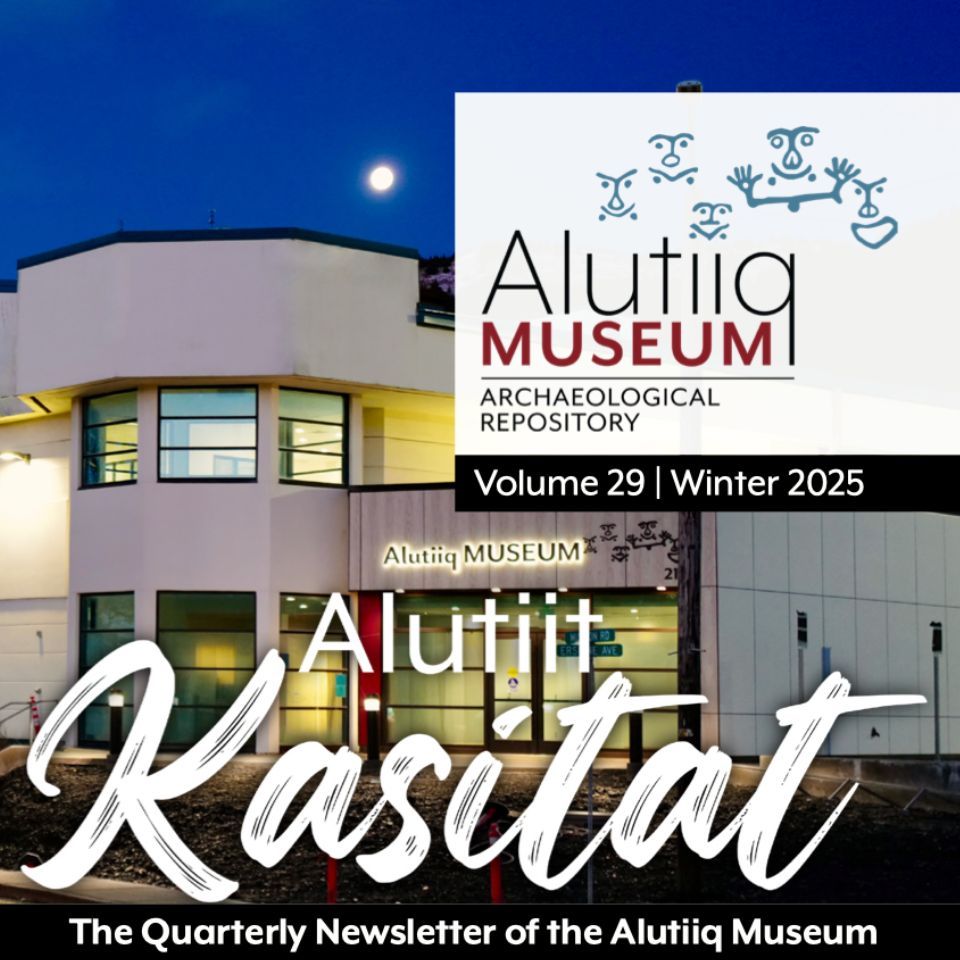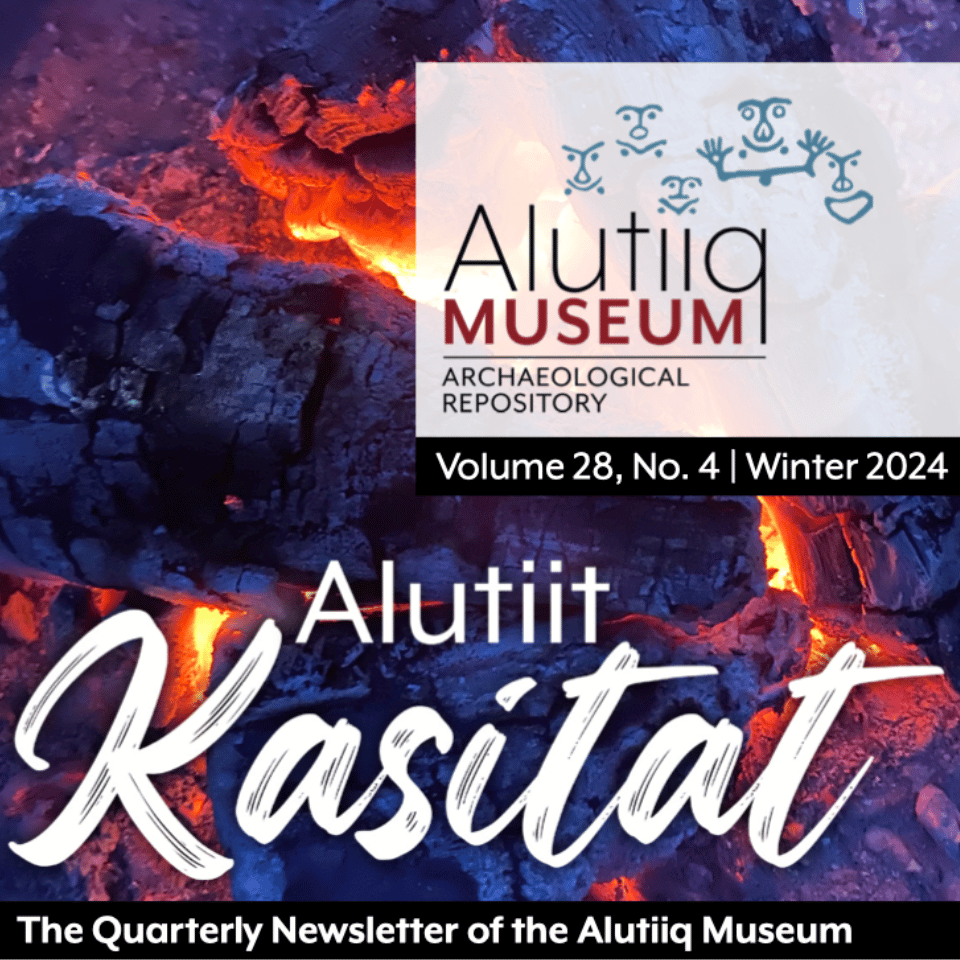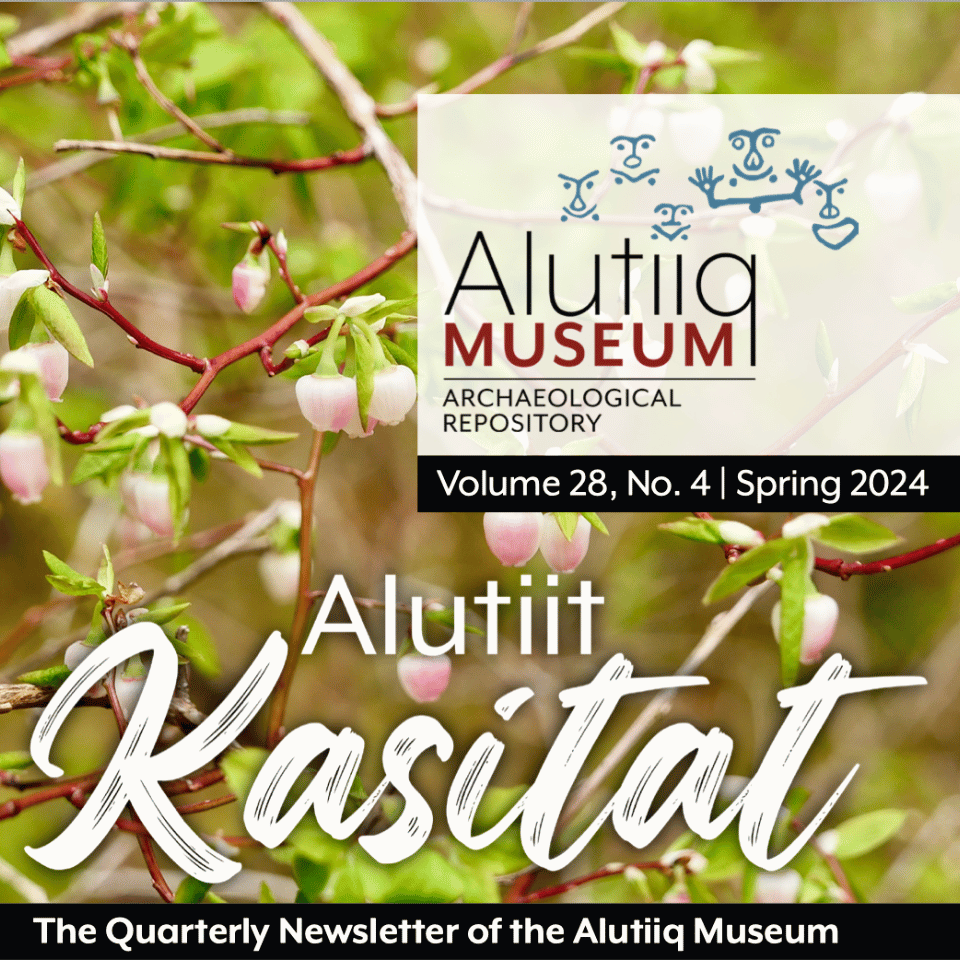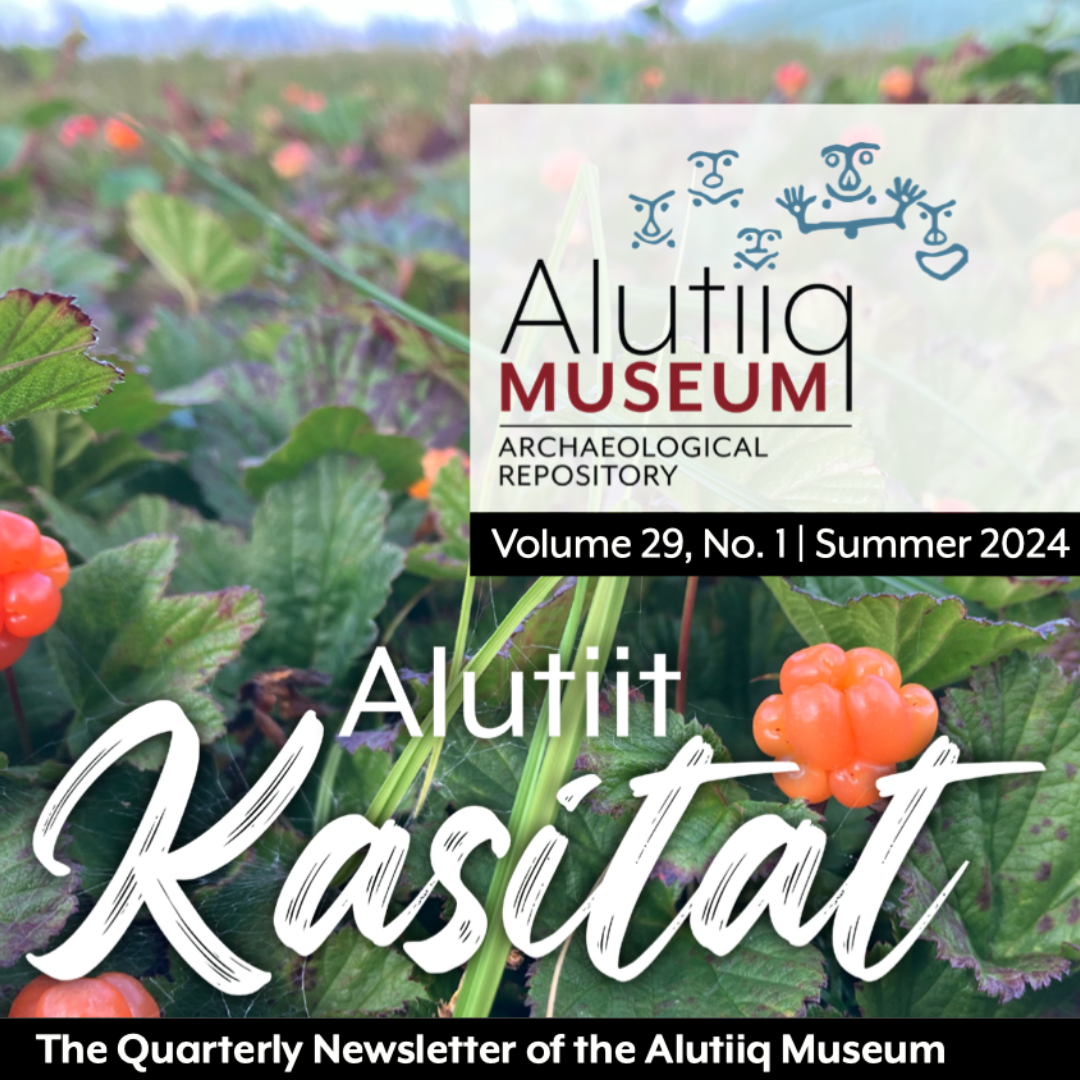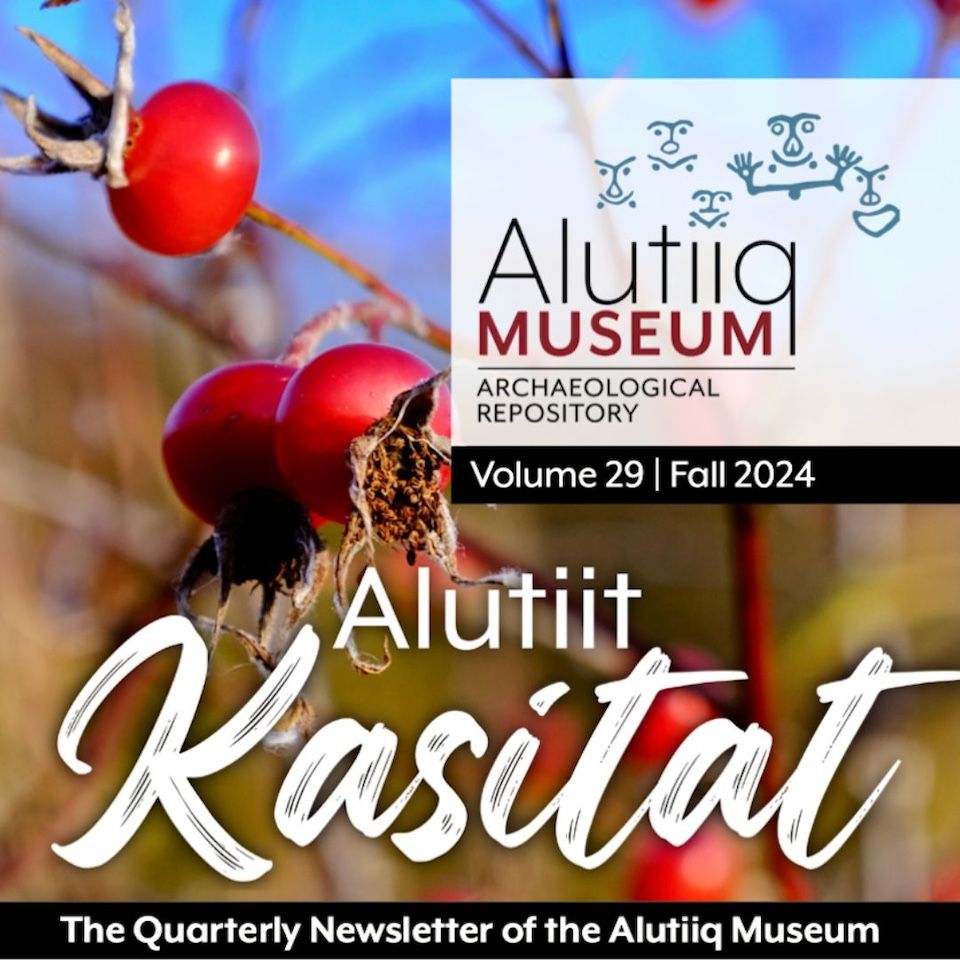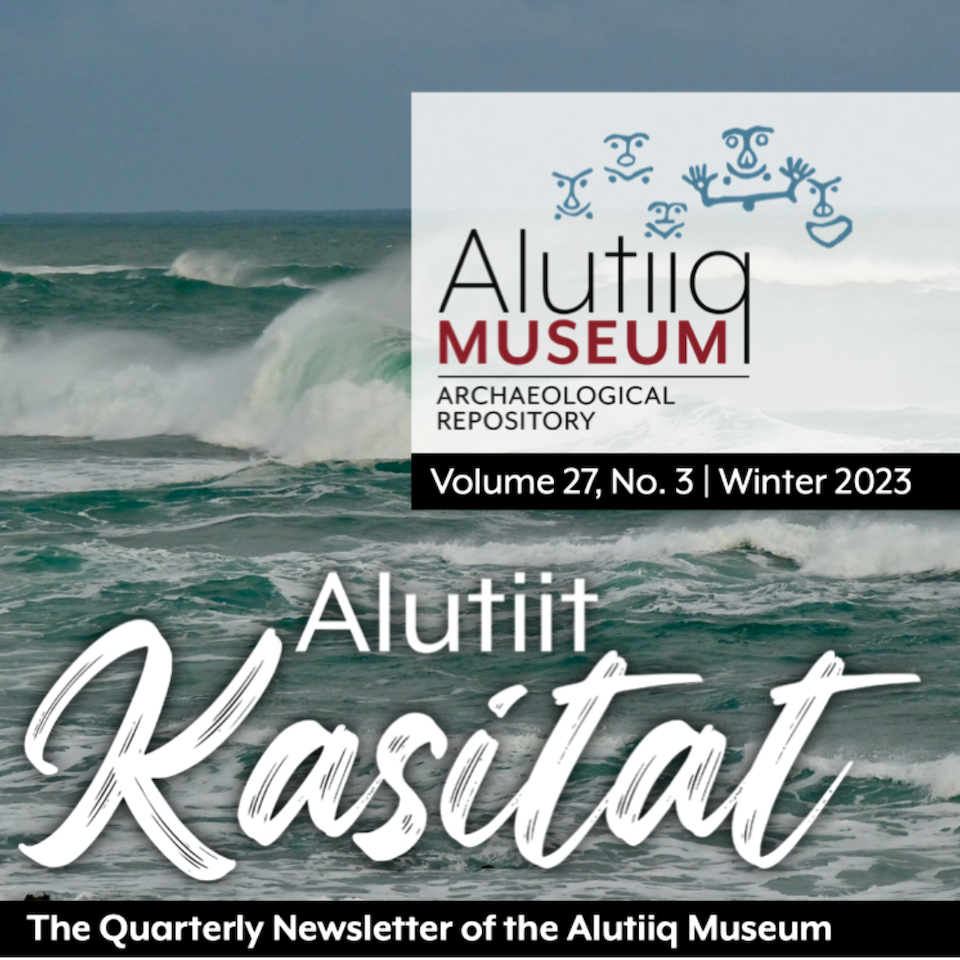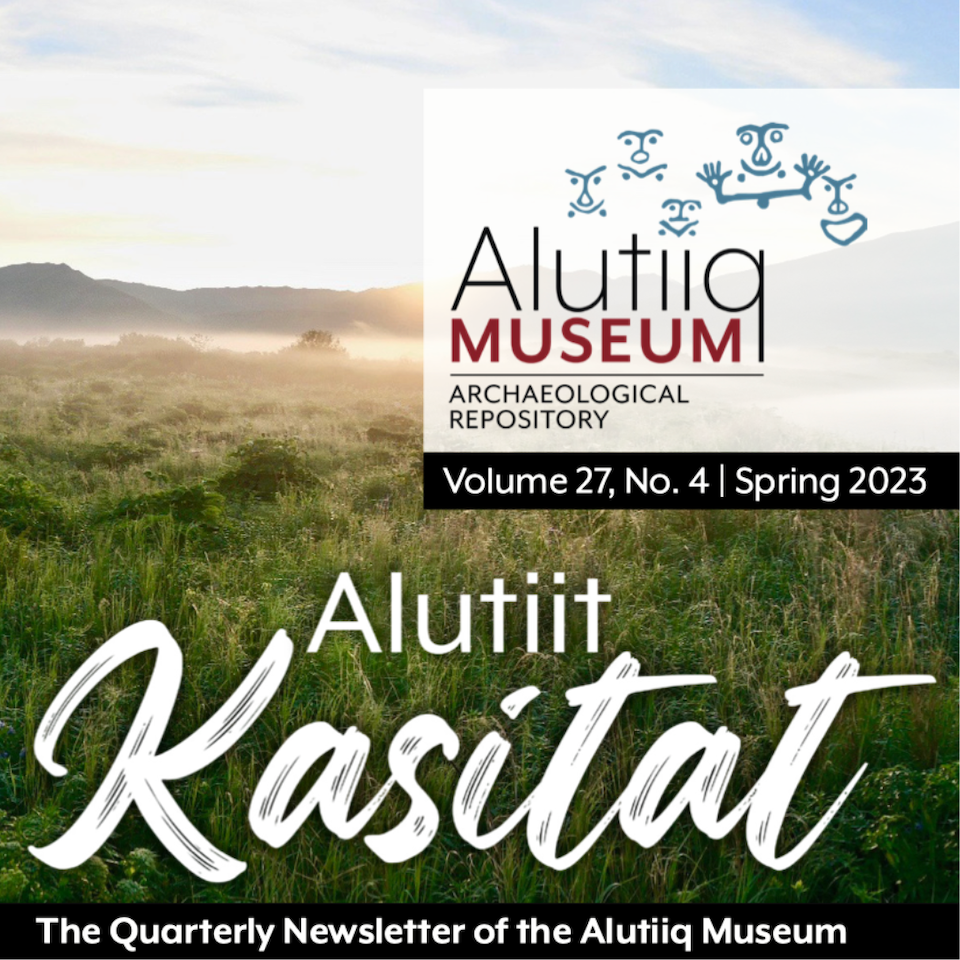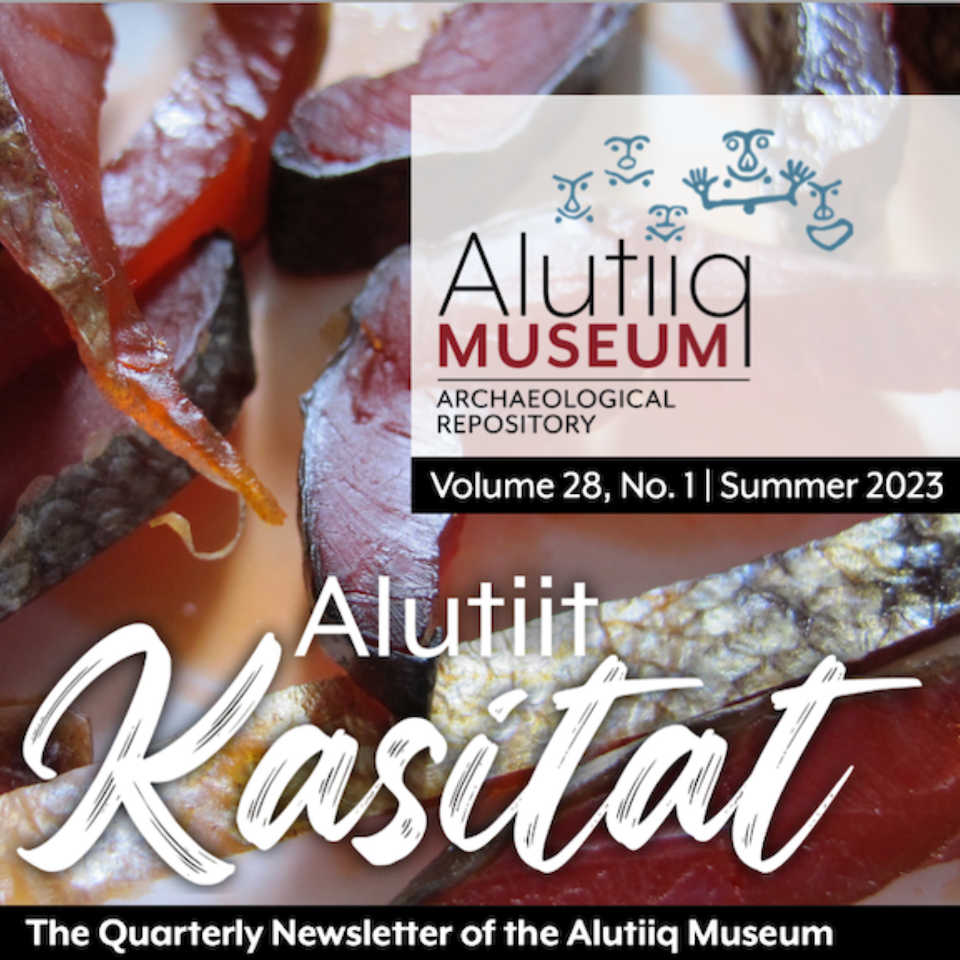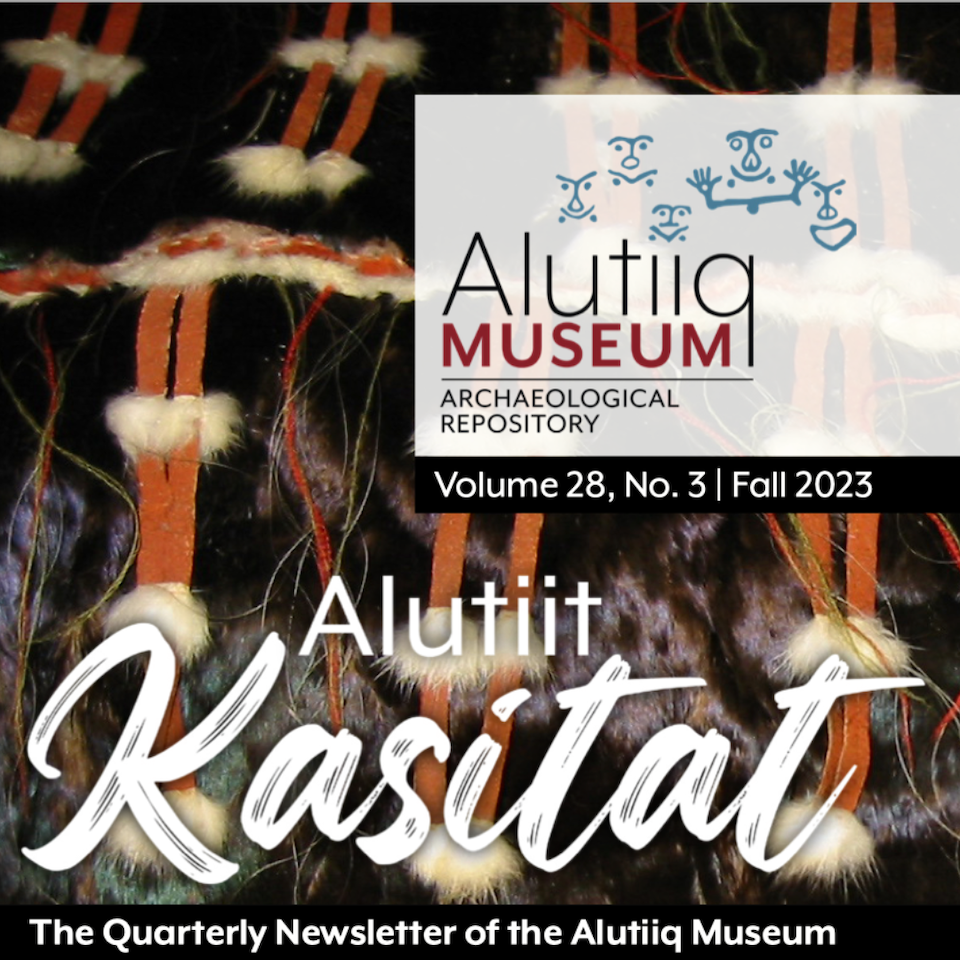News
Cama’i Mail
MONTHLY EMAIL BROADCAST
Start each month with an update on museum news with our email broadcast. Learn about upcoming events, connect to new resources, and find opportunities to work with us. If you would like to subscribe to Cama’i Mail, please contact Amy Steffian 844-425-8844, to be added to our distribution list.

Download a recent issue:
Quarterly Newsletter
ALUTIIT KASITAT—THE ALUTIIQ PEOPLE’S NEWS
The Alutiiq people’s news is published four times a year, with cultural lessons from the Alutiiq world and stories about the museum’s work. If you are interested in contributing an article to our newsletter please contact Amy Steffian. We also welcome sponsorships. Contact Djuna Davidson to learn more, or visit the sponsorship page of our website. Back issues of our newsletter are available on request. Please contact Amanda Lancaster, 844-425-8844, for an electronic copy.
2025 Newsletters
2024 Newsletters
2023 Newsletters
Press Releases
The Alutiiq Museum regularly shares information on its activities with the press. Click on a link below to read or download a recent press release. If you would like to receive our press releases by email, please contact Amy Steffian 844-425-8844, to be added to our distribution list.

On May 22, the Alutiiq Museum will reopen to the public. The museum has been closed to visitors since August 2023 to undergo expansion and renovation of its facilities. The multi-year, $14.3 M project added 3400 square feet to the building and greatly expanded the space available for community education and collections care. The renovation is now complete, and the public is invited to attend a series of Grand Reopening events. The celebration will take place May 22 through May 24 during Kodiak’s annual Crab Festival. It also marks the museum’s thirtieth anniversary.
“We are excited to share our beautiful new facilities with Kodiak,” said Executive Director April Counceller. “Our patrons made this transformation possible. They told us they needed more space for learning. We used their input to attract funding and design a renovation that will support museum services for decades. Our community also stepped up with exceptional support. We raised over two million dollars in our capital campaign. It is now time to welcome everyone back to the Alutiiq Museum.”
In preparation for visitors, staff members created an entirely new set of exhibits for an expanded exhibit hall. The displays share over 670 cultural belongings from the museum’s collections, fusing Alutiiq/Sugpiaq values, ancestral artifacts, historic photos, quotes from community members, and contemporary artwork into presentations emphasizing continuities in Alutiiq traditions. Other notable features include touchable petroglyph replicas, a play space filled with toys, audio stations with recordings of Alutiiq legends, a touch screen display of historic village photos, and a creation station. Here, visitors can make an art card inspired by petroglyph designs. Staff have also enhanced the museum store, now doubled in size, with new furniture and merchandise. And they developed an honor wall—a glass tile display in the new lobby with the names of renovation donors.
Grand Reopening events will include an evening celebration on May 22, from 4:00 to 8:00 PM, with Alutiiq dance performances, gifts of beaded necklaces, all new exhibits, and a red carpet photo fundraiser. The following day, on May 23, from 10:00 AM to 5:30 PM, the museum will host an Alutiiq/Sugpiaq film festival in its new workshop space, a large addition to the facility designed for cultural events. The festival will feature nine films exploring the Kodiak Alutiiq heritage movement. On May 24, from 12:00 to 5:00 PM, the public is invited to a Native Arts Market, where artists will sell directly to patrons. The artists will include Bianca Doran, Skyler Gertz, Samantha Heglin, Kathy Johnson, Susan Malutin, Native Village of Afognak, Mariah Stapelton, Brandy Thomas, Lisa Truitt, and Diana Velez.
All events are free to the public and include access to the museum’s new exhibits, thanks to generous sponsorship from Matson and Kodiak Diesel. Everyone is welcome to attend. Additional information on the events, including a program for the film festival, is available on the events page of the museum website.
Mask by Coral Chernoff.
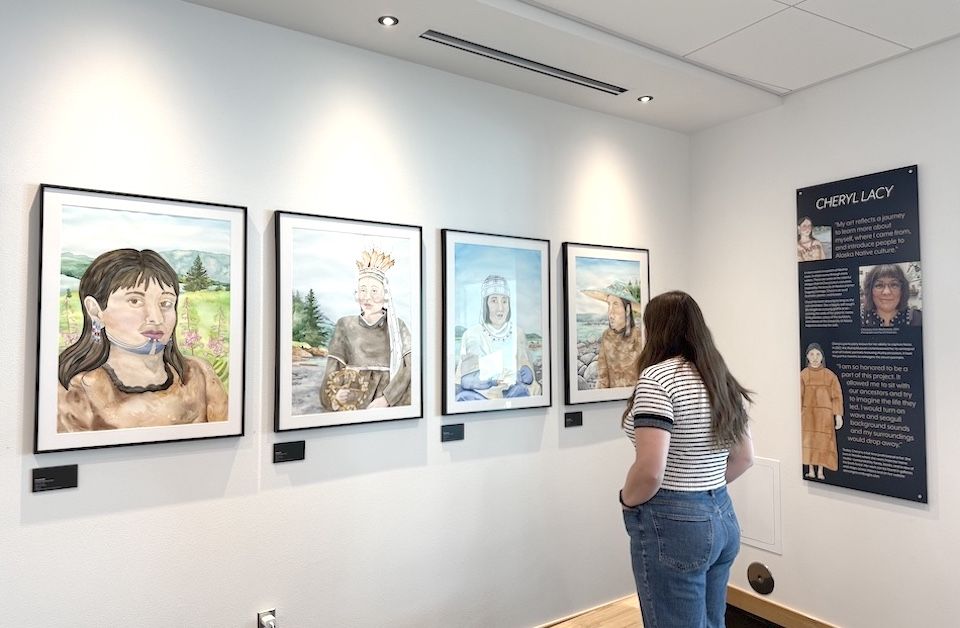
On May 22, the Alutiiq Museum will debut Cuumillapet—Our Ancestors, an exhibit of watercolor paintings by Sugpiaq artist Cheryl Lacy. The show is part of the museum’s Grand Reopening celebration. It features eleven portraits of Alutiiq ancestors, restyled from early 19th-century Russian paintings. Lacy captured the faces of Alutiiq people documented in the painting and then placed each in a Kodiak landscape. Cuumillapet—Our Ancestors is the first show in the museum’s new Living Culture Gallery—a space created for short-term exhibits as part of the recent building renovation.
“We are thrilled to share Cheryl’s paintings in our new gallery,” said Executive Director April Counceller. “Her lovely watercolors bring our ancestors to life and remind us that Alutiiq culture persists thanks to their strength. This is the first of many shows that will grace this special space. In the coming years, we look forward to featuring displays of all kinds, from locally curated art exhibits to presentations from archaeological studies, and visiting displays produced by other organizations.”
Cheryl Lacy is an avid illustrator, painter, and beader. She has been drawing for as long as she can remember, inspired by the beauty of Alaska and her Sugpiaq heritage. Cheryl is particularly known for her ability to capture faces. It took her just five months to reimagine the eleven portraits. She said, “I am so honored to be a part of this project. It allowed me to sit with our ancestors and try to imagine the life they led. I would turn on wave and seagull background sounds, and my surroundings would drop away.”
Lacy helped to develop the show, advising on the layout of the paintings and contributing to the text. She will travel to Kodiak to attend the show’s opening. Many organizations supported the development of Cuumillapet—Our Ancestors. Rasmuson Foundation supported the commission of Lacy’s painting through the Alaska Art Fund administered by Museums Alaska. The Frame Shop provided a substantial discount on framing the eleven large watercolors, a Grant-in-Aid from the Alaska State Museum supported exhibit production and travel costs, and funding from The CIRI Foundation supported staff time and framing.
Access to the museum’s Living Culture Gallery is always free. The public can visit Cuumillapet—Our Ancestors anytime during the museum’s regular hours. The museum plans to share the watercolor display for a year. A digital version is also available on the museum’s website.
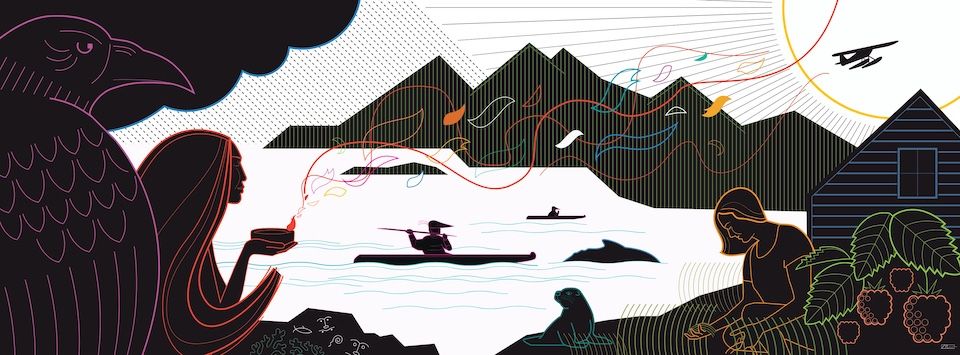
KODIAK—The Alutiiq Museum has unveiled The Fire of Living Culture, an outdoor mural featuring an original piece of digital artwork by Sugpiaq artist Todd Metrokin. The 13 by 35-foot vinyl wall hanging is displayed on the outside of the museum’s new addition—a workshop space created as part of a recent building renovation. The mural features bold graphic shapes shown in high contrast. The drawing is intended to capture attention from a distance and draw viewers toward the museum.
The mural project was part of the museum’s efforts to add cultural imagery to its building. Executive Director April Counceller explained. “For this month’s Grand Reopening, we wanted to share a large piece of contemporary artwork—as a celebration of our living culture and a visitor aid. In the past, people have had trouble finding the museum. The mural is part of an effort to help people locate our building and feel welcome. We have also added a new sign to the front of the museum, and our name and petroglyph logo now appear above the front door.”
Metrokin’s artwork mixes local scenery and cultural images—a woman holding a burning naniq–oil lamp, men paddling kayaks, the cultural hero Raven, a berry picker, and a float plane. He said, “My design concept connects our past to our future—from creation (represented by the raven) to our ancestors to modern life and beyondthrough the enduring flame of the naniq. The naniq’s flame echoes through time and grows richer in colors as it reflects a culture continuing to grow. This represents the resilience of our people and is meant to act as a counterpoint to the notion that our culture is only a reflection of the past. It is a living, evolving blend of experiences, knowledge, and creativity that we bring forward and enrich with each generation.”
The museum selected Metrokin’s design through a competitive process. First, tribal artists were invited to submit examples of their work. From fifteen submissions, a volunteer review committee picked three artists to create draft mural designs. Then, the committee selected Todd’s concept as the winning entry. A grant from the American Indian Alaska Native Tourism Association (AIANTA), funded by the US Forest Service, supported the project. The mural will be displayed for the coming year.
Todd Metrokin grew up in Kodiak and has spent his entire life creating art. He tells stories through his illustrations, using ancestral symbolism to create a modern graphic language. His work ranges from minimalist illustrations to dramatic collages. Each piece is grounded by a strong composition with layers of pattern and details that invite the viewer deeper into the story. Metrokin currently works in Spokane as a creative director in advertising.
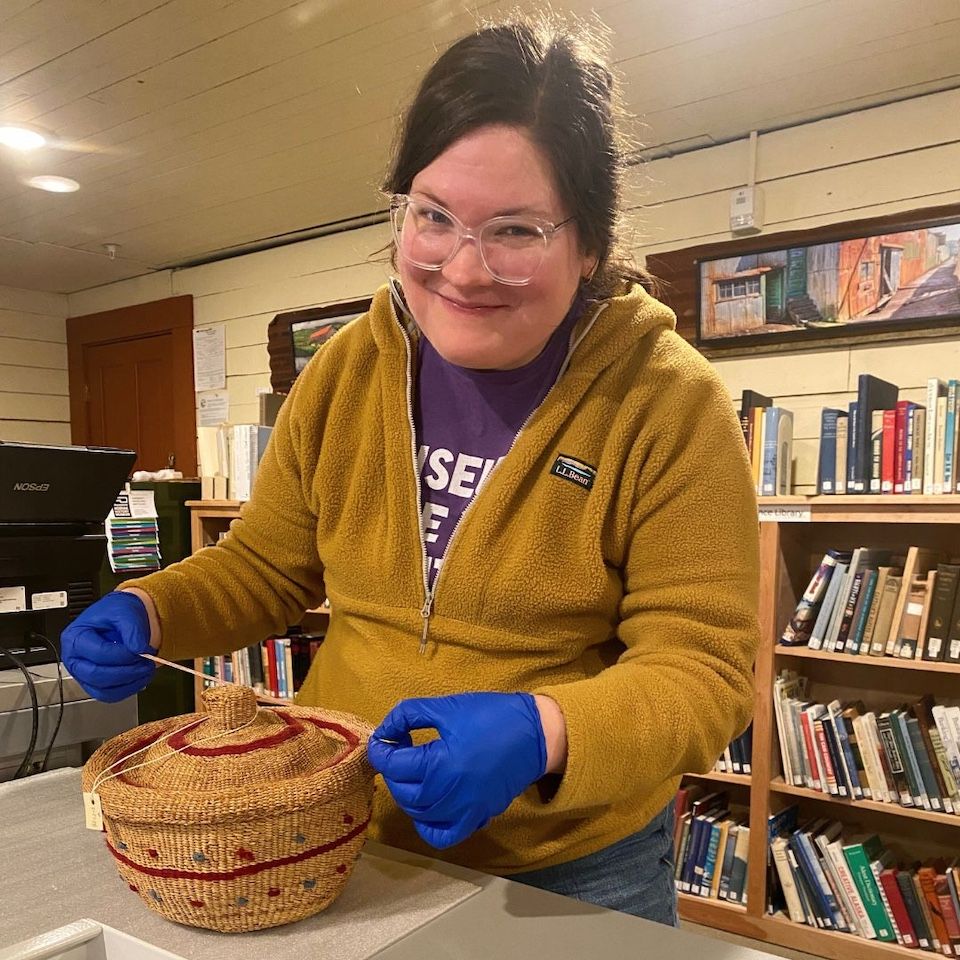
KODIAK—Every January, the Alutiiq Museum reflects on the many people who gave their time and talents to our previous year’s projects. Then, on Valentine’s Day, we select one outstanding contribution for our Volunteer of the Year award. For 2024, that recognition goes to Lynn Walker, a museum lover, graduate student, and the Curator of the Kodiak History Museum.
Originally from Michigan, Lynn moved to Fairbanks in 2016 to work on a PhD at the University of Alaska and then to Kodiak in 2021 to pursue her research. Even before she became an islander, Lynn volunteered at the Alutiiq Museum. She gave her time to a community archaeology project, excavating on Near Island and assisting with lab work.
This past year, Lynn supported the museum’s renovation. She served on the volunteer Exhibits Advisory Committee for months, reviewing text and designs for upcoming exhibits. With her background in exhibit development, Lynn was a remarkable resource. She read draft panels, attended long meetings, and brought thoughtful comments from her knowledge of local history. She was a reliable evaluator, and her insights enhanced the displays. Lynn also gave her time to our collections move, sharing her expert knowledge of artifact handling. She helped to move ancestral objects and artwork into the new storage vault, aiding the safe transition of collections.
“Lynn’s commitment to service made a meaningful impact on the Alutiiq Museum in 2024,” said the museum’s Executive Director April Laktonen Counceller. “Museums are complicated organizations with a need for expertise in many areas. Volunteers provide essential support whether it’s chaperoning a school group, building artifact boxes, or contributing to committees that help to evaluate our work.”
For Lynn, volunteering is a way to support organizations she cares about. She said, “Volunteering is something I am quite passionate about . . . a way to get even more involved at a meaningful level. I may not be able to donate money, but I can donate my time, my skills, and my perspective.”
She also recognizes that volunteering helps her learn. “I really enjoyed my time both providing my own feedback and hearing the input of others. It helped shape how I approach topics in my work . . . I feel like a lot of people don’t understand what a museum does until they volunteer.”
To learn more about volunteering at the museum, please contact Djuna Davidson (844-425-8844; djuna@alutiiqmuseum.org). The Alutiiq Museum welcomes all volunteers, and no previous experience is necessary.
Photo: Lynn Walker studying baskets at the Kodiak History Museum. Courtesy of Lynn Walker.
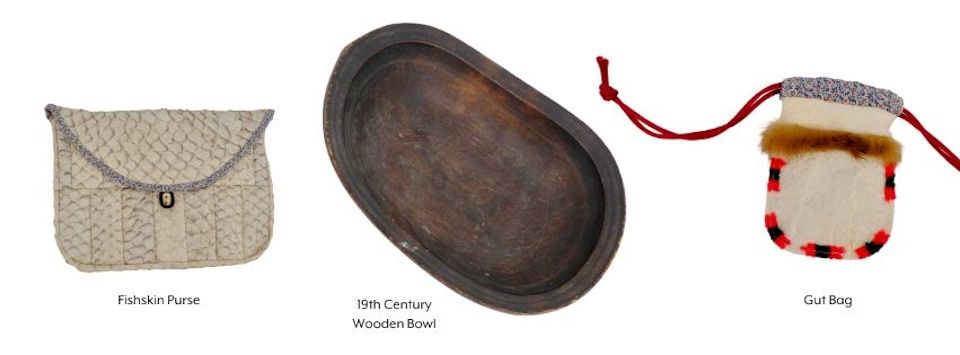
KODIAK—The Alutiiq Museum has received three cultural objects for its collections—a mid-19th-century wooden bowl collected on Kodiak Island and two skin bags created by Alutiiq artist Lalla Williams. The objects are from the collections of the Ralph T. Coe Center for the Arts, a non-profit organization in Santa Fe, New Mexico dedicated to exploring Indigenous arts. They were gifted to the Alutiiq Museum as part of a rehoming initiative for the Coe Center’s more than 2500-piece collection.
“We are grateful for the Coe Center’s interest in returning cultural objects to descendant communities,” said Alutiiq Museum Executive Director April Laktonen Counceller. “There is a growing recognition among museums that Indigenous communities are the best caretakers of their own cultural objects, and that these objects are important in helping Native people live their culture. The Coe Center invited organizations to apply to become stewards of items in their collections, and the Alutiiq Museum was awarded the pieces from our region. The Coe Center paid for packing and shipping to Alaska and will even provide a small grant to help with the care of the pieces. We are grateful.”
Carved from a single piece of wood, the bowl is likely a food-serving dish. It features a flat bottom, sloped sides, and a decorative rim with a shallow groove. The bowl is generally oval, although one end is gently pointed, like a boat or a mask.
The two contemporary bags reflect Lalla Williams’s sewing expertise and use of natural materials. One is a purse made of pale grey sea bass skin. It has an ivory clasp and a lining of flowered cotton cloth. The other is a small pouch made of seal gut accented with marten fur, yarn, leather, and cotton. Williams, an Alutiiq Elder from a Karluk family, currently lives in Anchorage. Before this gift, the Alutiiq Museum owned just three examples of her skin sewing—a parka and two hats.
The objects will be integrated into the museum’s collections and shared with the public through gallery and online displays.
“We have already found a place for the bowl in our new exhibits, in a display on household life,” said Counceller, “and photos of all three items are available on our website.”
Photo: Left–sea bass purse by Lalla Williams, Middle–wooden bowl by an ancestral artist, Right–seal gut bag by Lalla Williams.
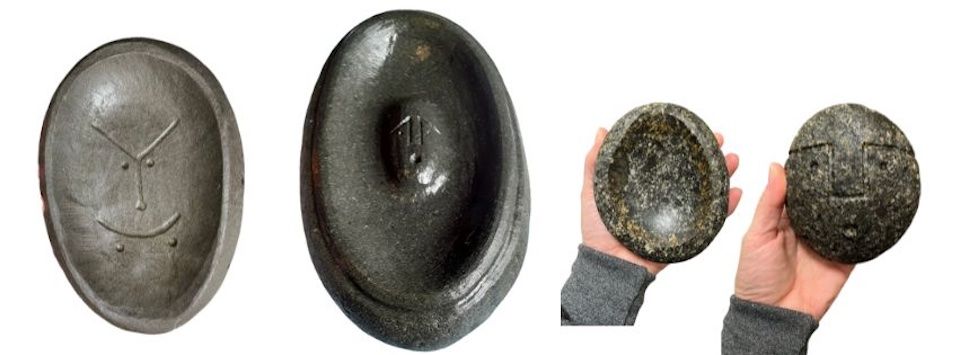
With a $16,950 grant from Museums Alaska, the Alutiiq Museum will purchase works from five artists for its permanent collection. The pieces are the creations of Rolf Lee Christiansen of Old Harbor, Cheryl Lacy of Wasilla, and Janelle Barton, Arlene Skinner, and Stacy Studebaker of Kodiak. They were offered to the museum through a public call for artwork last September, and then selected for their craftsmanship and connections to the museum’s mission. Alutiiq Museum Executive Director April Counceller explained.
“We are proud of our contemporary art collection,” said Counceller. “Our staff, volunteer collections advisory committee, and our board review every piece. This thoughtful process ensures we collect works that best exemplify Alutiiq traditions and the Alutiiq world. Over the past twenty years, the fund has allowed us to build a sizeable collection of contemporary art representing this era of our history—from the reawakening of traditions, to issues that impact our communities, and the environment that sustains us. It’s particularly meaningful that we can purchase additional works now—during national Native American Heritage Month. The selected pieces will help us tell Alutiiq stories in our exhibits, publications, and educational programs for years.”
From Christiansen, the museum will purchase a set of three hand-carved stone oil lamps. Two of the lamps have petroglyph engravings. The third has a mask sculpted in the bowl—a relief carving designed to emerge as the oil burns. The lamps are made from water-rounded cobbles collected on the beach below Refuge Rock—where a 1784 massacre of Alutiiq people by Russian traders took place. Today Refuge Rock is on Native land near Christiansen’s home. By creating beautiful cultural objects from rocks collected in this infamous location, Christiansen demonstrates the persistence of his people and culture. Two and a half centuries after the massacre, the Alutiiq have reclaimed the Refuge Rock and are reawakening traditions suppressed by colonialism.
From Lacy, the museum will purchase How Big Was Your Fish?, a three-dimensional beaded mask. Nineteenth-century Alutiiq masks inspired this piece. The work includes the traditional mask parts—a face, hoop fitted with decorative attachments, and cross braces – covered in beadwork. There are also subtle beaded petroglyph designs in the mask’s face. Lacy’s piece shares ancestral designs in a modern format. In her proposal, Lacy said, “I’ve always wanted to make an Alutiiq mask, but I don’t know how to carve. I do know how to bead.”
From Barton, the museum will purchase a pair of baleen bracelets—one of humpback and the other of grey whale baleen. Barton cleaned, carved, bent, and polished the baleen to create pieces that resemble traditional cuffs worn around the wrist of a kanaglluk—gut skin jacket. Although widely used in ancestral technologies, baleen working faded in the nineteenth century as commercial whale harvesting supplanted Alutiiq hunting. Barton’s work represents efforts to reintegrate this valuable material into artistic practice.
From Skinner, the museum will purchase Contemporary Woman’s Spruce Root Hat. Made from locally harvested spruce root, this hat is modeled after ancestral pieces featuring a wide, gently sloped brim encircling a conical cap. Among the Alutiiq, spruce root hats were typically worn by men and decorated with hunting talismans. Skinner’s reinterpretation is designed for a woman. She uses the classic form but signals femininity with decorations. The edge of the hat is trimmed in fluffy, pink cotton fabric, the cap has train of white mohair, and glittery beads and shells provide embellishment. Spruce root hats are difficult to weave. Skinner’s piece will be only the second complete example in the museum’s holdings.
From Studebaker, the museum will purchase Western Sandpiper at Low Tide, a color pencil drawing of a shorebird in Kalsin Bay. The naturalistic drawing shows the animal in its environment. It reveals both an intertidal species Alutiiq people have a history of harvesting and the shoreline habitat in which the bird lives. Alutiiq Elders report hunting such birds at low tide at night and adding them to soups and stews. The drawing helps to reveal the diversity of bird life in the Kodiak region and provides an opportunity to discuss the importance of birds to subsistence and spirituality.
Support for these purchases comes from the Alaska Art Fund. Established by Rasmuson Foundation in 2003, the fund promotes the development of contemporary art collections in Alaska museums. Museums Alaska, the state-wide museum association, administers the fund. Images of the recent purchases can be seen in the contemporary art gallery on the museum’s website.
Photo: Stone oil lamps by Alutiiq artist Rolf Christiansen.
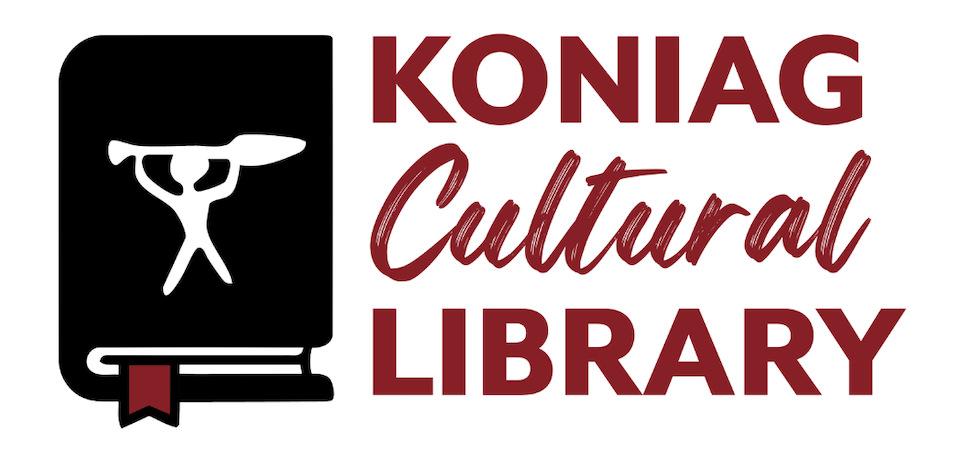
KODIAK, Alaska—A $149,451 grant to Koniag from the Institute of Museum and Library Services will help the Alutiiq Museum make improvements to its library. The funding will support the Liigwik—Learning Place project, an effort to enhance public use of the Koniag Cultural Library by outfitting a new library space in the renovated museum building and hosting a series of library events.
“This project is part of our broader efforts to invite more public use of the museum and its resources,” said Executive Director April Counceller. “Many people don’t realize we have a research library. For many years, the collection was in the museum basement. It was difficult to access and patrons had to make appointments. With the museum’s renovation, we are able to put the library in a larger second-floor space and offer public hours.”
Founded in 2018, the Koniag Cultural Library is the official tribal library of Kodiak’s regional Native corporation, Koniag. The Alutiiq Museum owns and manages the collection for the benefit of the tribal community and the public. At present, the library contains over 3,800 pieces of printed material, 208 audio-visual items, 2.4 linear feet of vertical files, and 11,000 photographs reflecting Kodiak, the Alutiiq world, and the museum’s work. Curator of Collections Amanda Lancaster serves as the librarian.
The Liigwik—Learning Place project will rehouse and share library materials. In the coming months, staff members will move the library into its new home in the Alutiiq Center. Grant funds will provide furnishings—shelving, tables, seating, signage, and two computers. Starting next fall, staff will host library events to connect patrons to library resources, including genealogical resources.
“Our goal is to create a better functioning library,” said Counceller. “We receive hundreds of requests for information about the Alutiiq world each year, requests that demonstrate a deep interest in exploring Alutiiq history, language, and traditions. Liigwik will transform our library into a learning center. It will elevate the library program to the level of other AMAR programs. And when Kodiak learns about Alutiiq people, we address lingering stereotypes, elevate respect for Native people, and build a stronger community.”
Image: New library logo designed by April Counceller
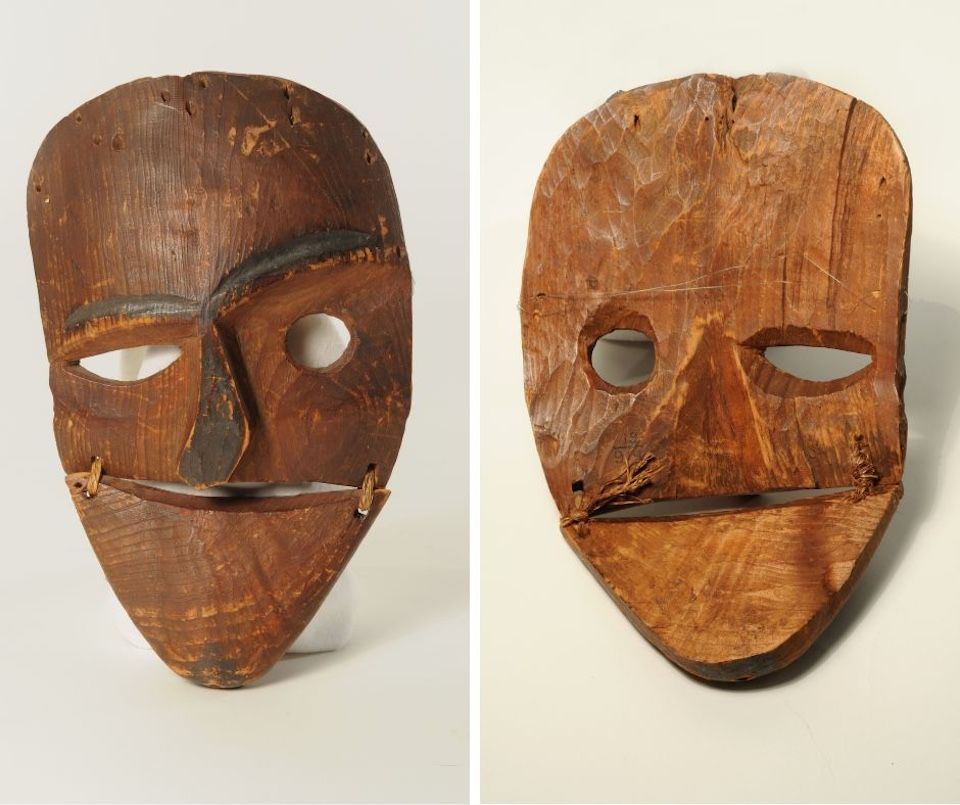
KODIAK, Alaska—An ancestral mask collected on Kodiak Island has been transferred to the Alutiiq Museum. Records suggest that the rare ceremonial carving may have been made around 1820, during the height of the Russian fur trade. However, the mask’s early history is unknown. In the 1980s, the mask was purchased in a Montreal gallery, and in 1991 it was donated to McMaster University’s Museum of Art in Hamilton, Ontario, Canada. Recognizing the carving’s spiritual significance and the importance of transferring it to an institution aligned with its heritage, McMaster offered the piece to the Alutiiq Museum. In September, the mask returned to Kodiak.
“We were so happy to receive this mask,” said Executive Director April Laktonen Counceller. “We were not aware of its existence. McMaster University took the time to find our institution, explain the situation, complete transfer paperwork, pack the piece in a custom-made box, and ship it to Alaska. They were not required to return it, but we are glad they did.”
The mask is unique. It is small, about 28 x 17 cm, and in two pieces. The lower half of the face is lashed to the upper half, creating a space representing a mouth. Although it features the heavy brow found in other Alutiiq masks, the piece has an unusual asymmetrical face. Its creator carved a tilted brow, bent nose, and one partially closed eye. The design is similar to an ancestral mask from Karluk and to asymmetrical masks made by neighboring peoples. Some people believe such carvings are shamanic and show a spiritual transformation in progress. Others suggest that asymmetrical faces represent a particular spirit in the cosmology of arctic peoples.
Pictures of the mask are available on the Amutat database, a collection of photographs of Alutiiq ethnographic objects on the museum’s website. The public is invited to see the mask on Friday, November 1 at the Alutiiq Museum Store at the Downtown Marketplace. The museum will share the piece in honor of Kodiak’s First Friday Art Walk between 5 pm and 7 pm. This is a free event. Everyone is welcome.
Mask photos courtesy of the McMaster University Museum of Art.
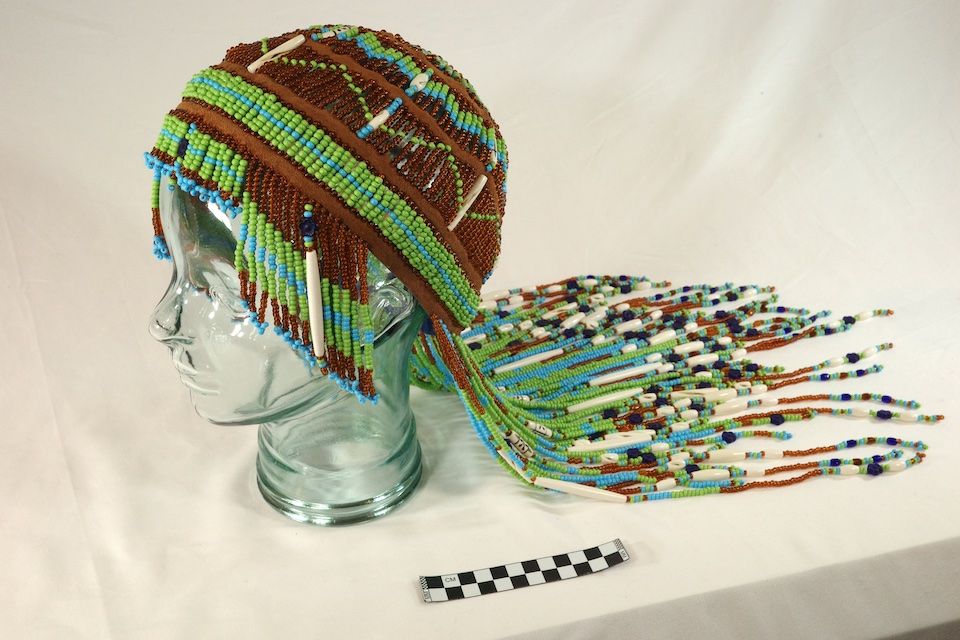
KODIAK, Alaska—two major grants to Alutiiq organizations will support the Alutiiq Museum’s efforts to create an entirely new set of displays for its renovated exhibit hall. In June, Koniag received a $231,889 grant from the Institute of Museum and Library Services to develop displays on Alutiiq subsistence, community life, and spirituality at the museum. In July, the Native Village of Afognak received $98,968 in grant funding from the US Bureau of Indian Affairs for museum displays exploring the impacts of Russian and American colonization. The funds will help the Alutiiq Museum tell the Alutiiq story from a new perspective. Executive Director April Counceller explained.
“Two years ago, we began planning the displays for our new galleries with audience assistance,” she said. “Through this process, we developed a beautiful design. The galleries will be organized around four Alutiiq values and explore areas like ties to the land, social life, and spirituality. Visitors will also find a gallery devoted to recent history and updated versions of old favorites like our kayak display and children’s corner. The grants will help us take the designs from the computer to the gallery!”
To assist with this process, the museum is hiring an exhibit apprentice. “Exhibit projects are complex and the best way to learn is through hands-on experience,” said Counceller. “The grant funds will allow us to use this once-in-a-generation project for training. We are hiring a full-time exhibit apprentice to work beside Exhibit Manager Alexandra Painter.” Those interested in the position can find application materials on the opportunity page of the museum’s website.
Starting this month, staff will build mounts for hundreds of objects planned for display—from tiny artifacts to parkas and paddles. Then, with professional support from welders, carpenters, and painters, the museum’s team will build the displays and install objects for a grand reopening in May 2025.
“We are planning a week of celebration to debut the new exhibits, share our enhanced facilities, honor our many generous contributors, and share our culture,” said Counceller. Updates on the renovation can be found on the renovation page of the Alutiiq Museum website.
Other generous contributors to the museum’s upcoming exhibits and their supporting educational materials include the Alaska Office of History and Archaeology, Alaska State Council on the Arts through the Munartet project, American Indian Native American Tourism Association, EVOS Trustee Council through the CORaL Partnership, GCI Gives, The CIRI Foundation, Trident Seafoods, and US Coast Guard Spouses Association of Kodiak.
Photo: Beaded headdress by Emily Jean Capjohn planned for display in the museum’s new exhibits.
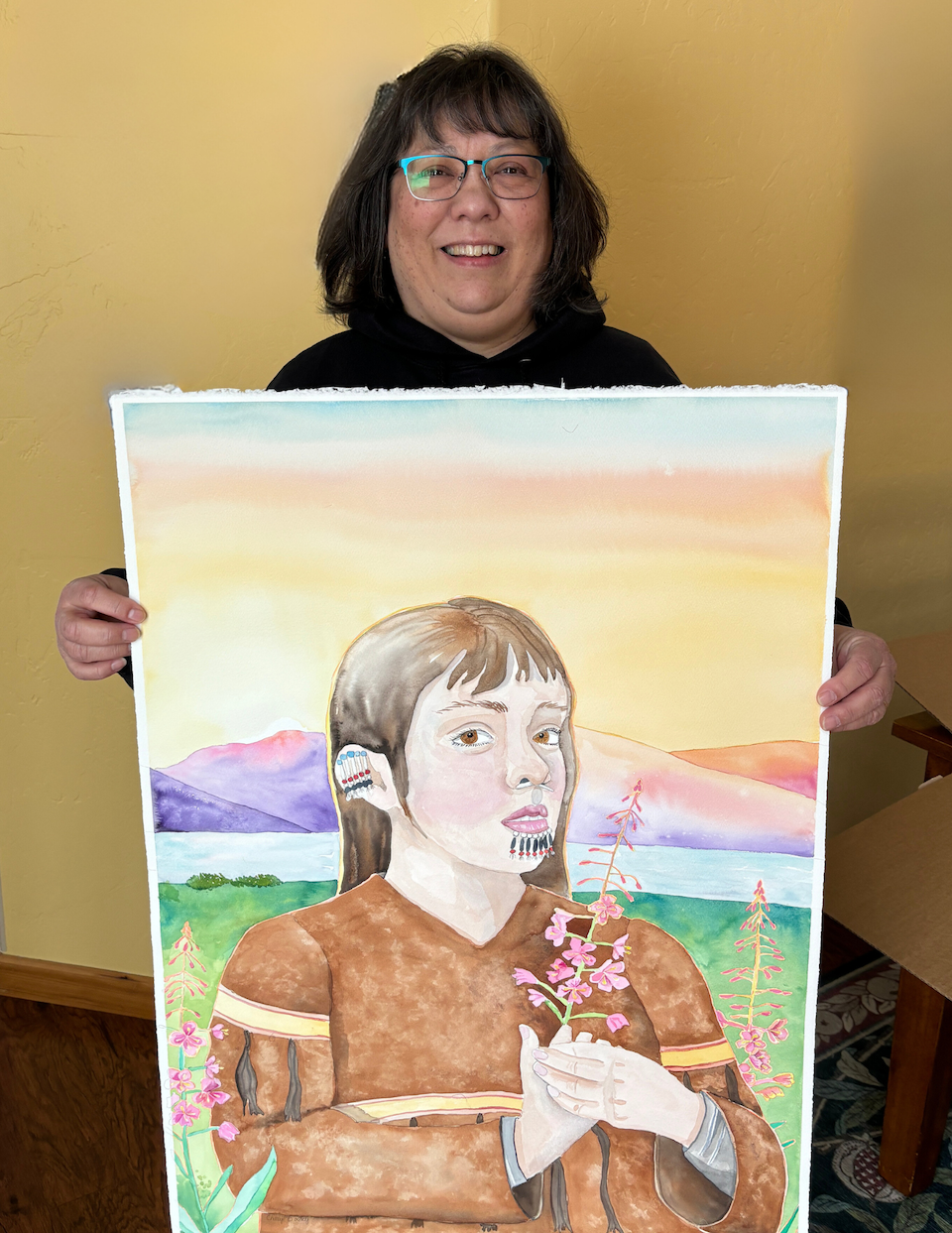
KODIAK, Alaska—The Alutiiq Museum has added 11 watercolor portraits of 19th-century Alutiiq/Sugpiaq people to its collections. Created by Sugpiaq artist Cheryl Lacy, the set reinterprets watercolor paintings made by Mikhail Tikhanov, a Russian artist from Saint Petersburg who visited Kodiak in 1818. It is titled Our Ancestors. Lacy’s paintings capture the faces and clothing of Kodiak’s Native people and add scenic backgrounds. Her work transforms scientific illustrations painted on blue backgrounds into images that bring Alutiiq ancestors to life. A $15,500 grant from the Alaska Art Fund, administered by Museums Alaska with support from Rasmuson Foundation, paid for the commission.
“Tikhanov’s portraits are some of the oldest images of our ancestors,” said Alutiiq Museum Executive Director April Laktonen Counceller. “He painted individuals in great detail, capturing their facial features, clothing, hairstyles, tattoos, jewelry, and tools. He even recorded some of the people’s names and the places they were from. Unfortunately, many of his paintings show the same person from two perspectives—a front view and a side view—as if they were scientific specimens. They are an artifact of the colonial era.”
To remove the colonial perspective but preserve the faces of Alutiiq ancestors, the museum commissioned Lacy to create new paintings. Staff members provided her with photographs of landscapes tied to the homes of Tikhanov’s subjects. It took Lacy just five months to create the set. She restyled each portrait, combining front and side views of the same person into a three-quarter view.
Tikhanov’s paintings show the growing influence of Russian customs on Alutiiq people as expressed in their clothing and names. However, they also demonstrate the persistence of an Alutiiq way of life in traditions like tattooing, nose piercing, and personal adornment. They are a trove of information. The Alutiiq Museum plans to show the paintings in its new living culture gallery next May. A selection of the portraits will also be included in a book on contemporary Alutiiq art currently in development.
“These paintings will help us share the faces of actual ancestors in many ways,” said Counceller. “Cheryl is talented at capturing people and she used bright colors, living landscapes, and large canvases to bring our relatives to life. Her portraits are stunning.”
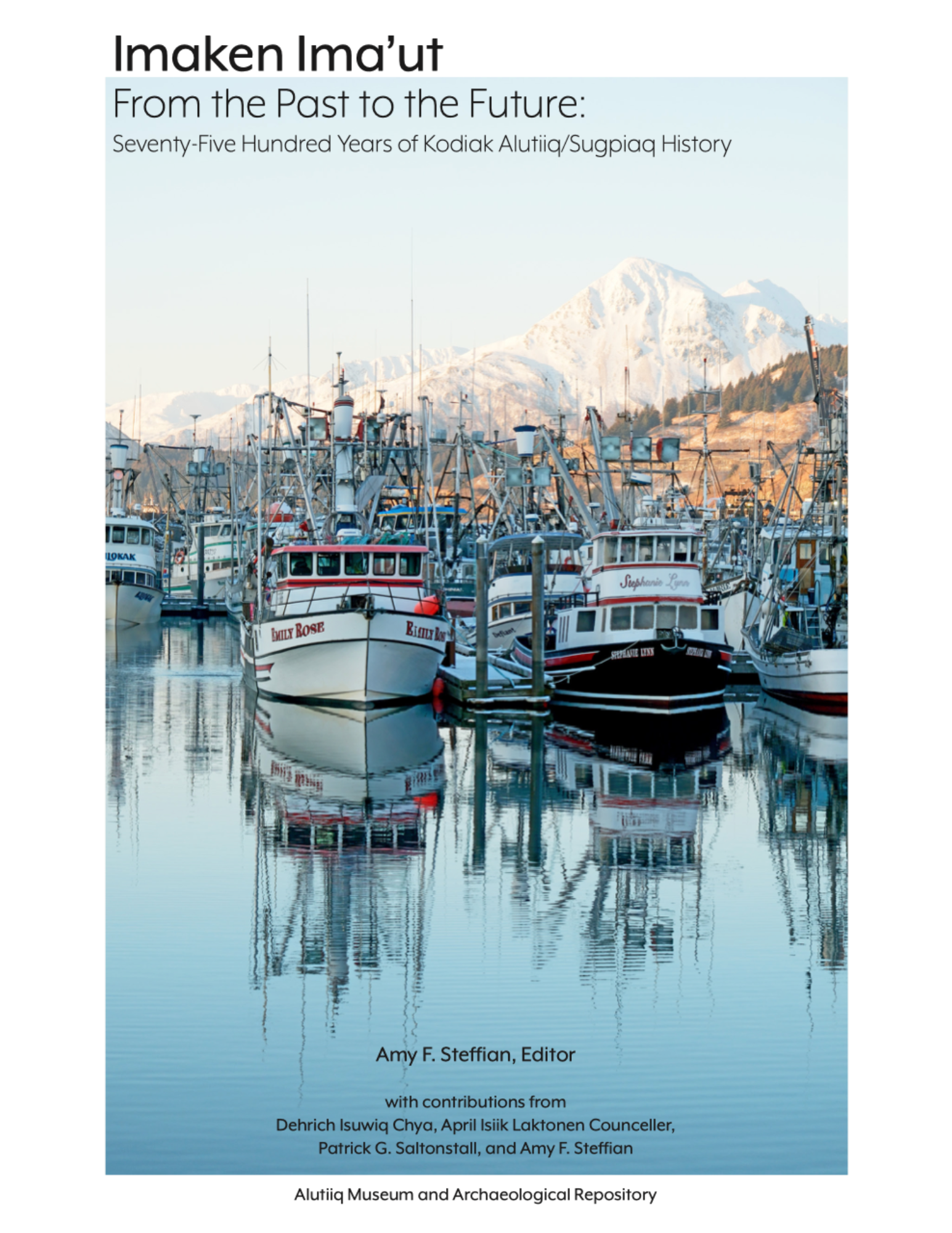
KODIAK, Alaska—The history of the Kodiak Alutiiq/Sugpiaq people is the subject of a new book released today by the Alutiiq Museum. The 188-page paperback, titled Imaken Ima’ut—From the Past to the Future, traces the history of Kodiak’s Native people over more than seven millennia. Written for a public audience, it provides an accessible account of Alutiiq history told by local scholars and with Alutiiq perspectives. It was funded by a grant to Koniag by the Institute for Museum and Library Services.
“A few years ago, the museum held a tribal summit where we shared Alutiiq history,” said April Laktonen Counceller, the Alutiiq Museum’s executive director and one of the book’s authors. “We gave presentations to delegates from ten tribes and then asked what the museum should be sharing. Up to that point, we’d focused on teaching about Alutiiq traditions and had not delved into recent history. Many people were surprised by what they learned and everyone urged us to tell a fuller Alutiiq story. That discussion was part of the impetus for this book.”
Four museum staff members wrote, edited, and designed the five-chapter publication. It begins with a discussion of the importance of tribal histories and the sources of information used to build the book. Then, the authors explore the Alutiiq past. Two chapters written by museum archaeologists Patrick Saltonstall and Amy Steffian look at Kodiak’s deep human history, synthesizing information on the peopling of the archipelago and the evolution of ancestral cultures. Then Alutiiq scholar Dehrich Chya shares the Russian conquest of Kodiak. He considers the economic, educational, and spiritual forces that dramatically altered Alutiiq life over a tumultuous century. Counceller continues this investigation with a review of the American era. She considers how Western industries, educational systems, and policies impacted the Alutiiq after the Alaska purchase, and then traces the development of the Alutiiq cultural renaissance from its roots in the land claims era to the present. Both Chya and Counceller provide Native perspectives on events that have often been told through Western accounts.
The presentation is heavily illustrated with over two hundred images from the museum’s collections and numerous sidebars. The sidebars share short summaries of related information. For example, in a discussion of the fur trade, readers will find a sidebar about Alutiiq hunters taken to California. Each chapter ends with a glossary of Alutiiq words and a list of references. The book ends with an introduction to its authors and a detailed index.
“We designed the book to be engaging and accessible,” said Counceller. “It is carefully researched by our team and then presented in a way that makes the information understandable. We believe it will be a valuable resource for Alaska history classes. Imaken Ima’ut brings Alutiiq history to life, and we know that’s important for Native youth. Our children do better in school when they see their heritage reflected in their lessons.”
Copies of Imaken Ima’ut are being distributed for free to Kodiak schools, Native organizations, libraries, and the museum’s educational partners. On April 18th, free copies will be offered to the public at a presentation and book signing hosted by the Kodiak National Wildlife Refuge Visitors Center. The event will start at noon and provide books while supplies last. Additionally, a free downloadable eBook of Imaken Ima’ut is available on the publications page of the museum’s website. Paper copies can be purchased from the Alutiiq Museum Store for $25.

